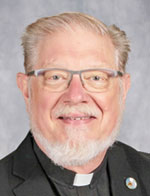That All May Be One / Fr. Rick Ginther
Christians believe Mary plays important role in God’s plan of salvation
 May is one of two months when Roman Catholics focus upon Mary. We crown an image of Mary. We pray the rosary more often. We bring flowers.
May is one of two months when Roman Catholics focus upon Mary. We crown an image of Mary. We pray the rosary more often. We bring flowers.
We do these things to honor Mary as the Mother of our Lord. Despite what some think, we do not worship her.
Through the centuries, the Church has declared four dogmas about Mary: Mother of God (Theotokos), Ever Virgin, Immaculate Conception and Assumption.
Each of these are rooted in the early Church fathers and theologians.
The dogmatic promulgations spanned 1,500 years: 431 (Theotokos); 649 (perpetual virginity); 1854 (conceived without sin), and 1950 (assumed into heaven).
In recent years, there has been an uptick in devotion to Mary among Protestant Christians. Their devotion is mostly biblically based.
Episcopalians tend to pray the Hail Mary and the Angelus much like we do. Lutherans and other Christians only pray the first part of the Hail Mary, based in Luke, Chapter 1—if at all.
Because most of the decades of the rosary are biblically based, this ancient prayer form is prayed by some Episcopalians (Anglicans) and Lutherans. They use either Anglican prayer beads (an “ecumenical rosary”) or the recently created unique Lutheran “rosary” known as the Wreath of Christ.
Episcopalians do pray intercessory prayers, asking Mary and other saints to intercede. Most other Christians (Methodists, Lutherans, Baptists and Evangelicals) do not share this practice. They see Jesus as the only true mediator.
When it comes to the four Marian dogmas, there is a wide variety of acceptance.
Episcopalians honor Mary and the biblical events of her life. They do not accept as dogma her perpetual virginity, Immaculate Conception or assumption. However, some hold these as “pious opinions.”
Lutherans hold Mary in high esteem, following the example of Martin Luther. They believe in Mary as Theotokos and in her remaining a virgin after the birth of Christ.
They see the Assumption indifferently (not commanded nor forbidden in the Bible). Lutheran denominations vary on which doctrines they teach.
United Methodists honor the Virgin Mary as the Mother of God (Theotokos) and teach as doctrine the virgin birth of Christ.
For Baptists, Mary is a person like any person. She was called to a unique role in God’s plan of salvation, chosen through God’s grace despite her human imperfections.
Oriental Orthodox are divided on the acceptance of the Immaculate Conception.
The Eastern Orthodox reject it due to differences in the understanding of original sin, although they do affirm Mary’s purity and preservation from sin.
Most of Orthodoxy accept an equivalent belief to the Assumption. It is entitled the Dormition of the Mother of God (falling asleep). They leave open whether Mary died or whether she was raised to eternal life without bodily death. The Catholic Church shares this openness about whether or not Mary died. Pope Pius XII specifically left this an open question when he infallibly defined the Assumption as a dogma in 1950.
Orthodox Churches have icons of Mary. Episcopal churches may have some statue or paintings of Mary. Both seek her intercession.
Lutheran churches have few images of Mary, except in windows depicting biblical events. Methodist, Presbyterian, Baptist and Evangelical churches do not.
As you can see, all Christians do view Mary as an important person in God’s plan of salvation. The Bible is the universal factor in this.
The Catholic Church and the Orthodox Churches, though of equally ancient origin, are not in total agreement in how they pray to Mary or beliefs concerning Mary.
Protestant traditions surrounding Mary are less in agreement. But as I said earlier, her place as an object of devotion is growing.
Perhaps this information will lead you to a greater devotion to Mary and prayer for all of our Christian brothers and sisters.
(Father Rick Ginther is director of the archdiocesan Office of Ecumenism and Interreligious Affairs. He is also the pastor of Our Lady of Lourdes Parish in Indianapolis.) †
 May is one of two months when Roman Catholics focus upon Mary. We crown an image of Mary. We pray the rosary more often. We bring flowers.
May is one of two months when Roman Catholics focus upon Mary. We crown an image of Mary. We pray the rosary more often. We bring flowers.